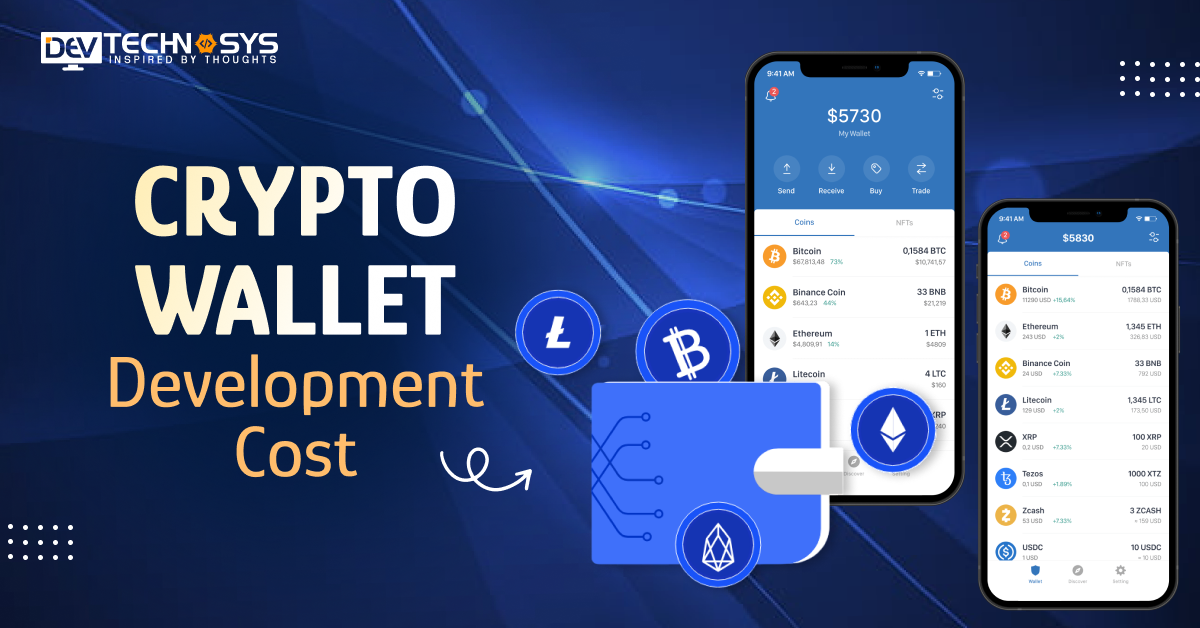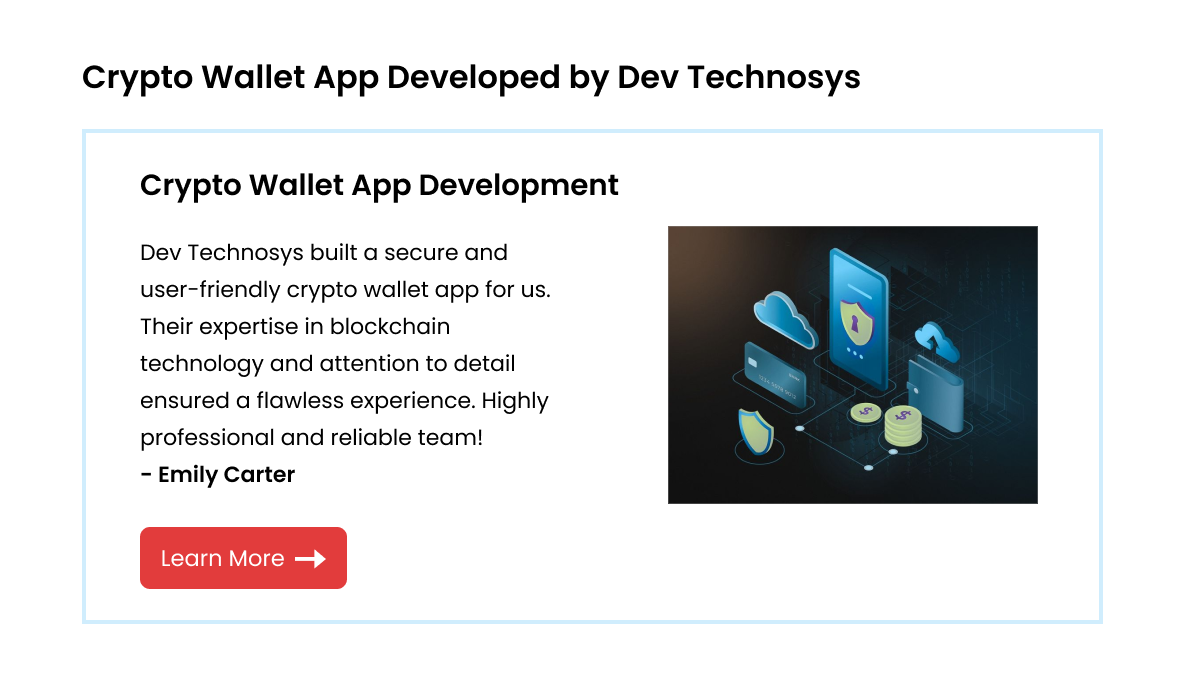Nowadays, in this world, everything is done digitally, whether you want to send money or when you want to go, even if the ticket is booked online. So, when we talk about digital currency, Then the first that comes to people’s mouths is “Cryptocurrency.” With the help of a Crypto wallet, users can send or receive digital money, and they can also store different types of cryptocurrencies in one platform, such as Bitcoin and Ethereum.
Have you ever imagined a custom crypto wallet? If yes, but you are worried about your biggest concern, what is the crypto wallet development cost? Now, we are here to take away your worries. We provide detailed information about how to create a crypto wallet app and the factors that are faced during the development.
Stay with us to know more about the overall cost!
What Is a Crypto Wallet?
A cryptocurrency wallet is a digital instrument for storing, sending, and receiving cryptocurrencies such as Bitcoin, Ethereum, and more. It stores private keys, which are required for accessing and managing your digital assets on the blockchain. There are two types of cryptocurrency wallets: hot wallets (connected to the internet for easy access) and cold wallets (offline for increased protection). Cryptocurrency wallet apps like Exodus enable users to securely conduct transactions, manage assets, track balances, and maintain privacy and control over their Bitcoin holdings.
- A crypto wallet securely saves your private keys for accessing and managing coins. This key is essential for transactions and owner control of digital assets.
- Send and receive digital money with crypto wallets. They show transaction history, let customers transfer cryptocurrencies, and send the right amount.
- Some crypto wallets handle multiple cryptocurrencies, letting users store and manage them all. Among them are Bitcoin, Ethereum, Litecoin, and others.
- To secure private keys and prevent unwanted access, crypto wallets use encryption, multi-signature authorization, and 2FA.
Different Types of Crypto Wallets
Three primary categories of cryptocurrency wallet applications exist, each meeting distinct requirements in terms of functionality, security, and ease of use:
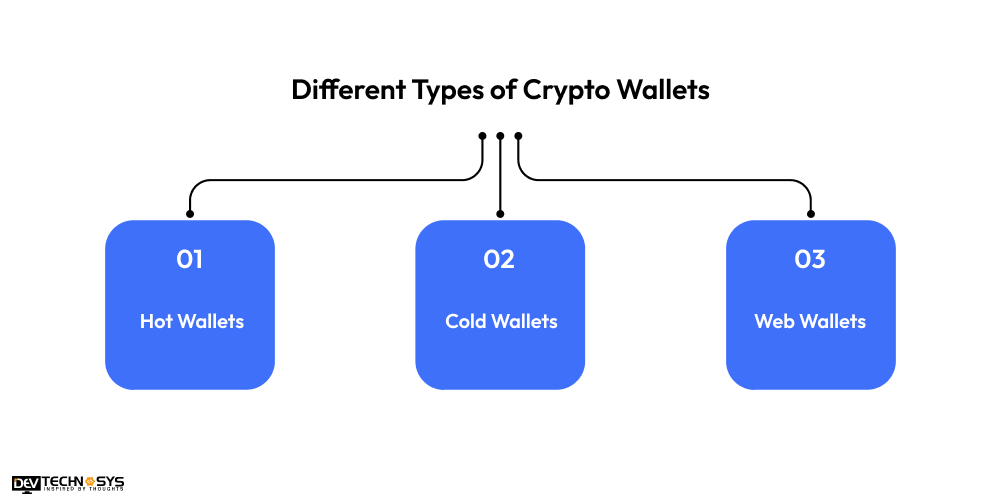
1. Hot Wallets
Hot wallets are internet-connected and made to make it simple and quick to access your cryptocurrency. Usually, desktop or mobile apps are perfect for regular transactions. Hot wallets are easy to use and facilitate quick transactions, but they are also more susceptible to hacking. Coinbase Wallet and Trust Wallet are two examples.
2. Cold Wallets
Cold wallets offer a high degree of protection by storing cryptocurrency offline. Due to their lack of an internet connection, these wallets are impervious to online hacking.
Although they are less practical for regular transactions, they are perfect for storing digital assets over an extended period of time. According to the crypto wallet development services provider, common examples of cold wallets are hardware wallets such as Trezor and the Ledger Nano S.
3. Web Wallets
Web wallets contain private keys online and can be accessed via a browser. Although they are more convenient because they can be used on various devices, they are not as secure as cold wallets.
For consumers who don’t care about long-term storage but still require quick access to their money, web wallets are perfect. MetaMask and Blockchain Wallet are two examples.
Market Analysis of Crypto Wallets
- Crypto Wallet Market size was USD 8.42 Billion in 2023 and is expected to expand from USD 10.51 Billion in 2024 to USD 77.21 Billion by 2032.
- According to the global market, It is anticipated that there will be 861.00 million consumers in the cryptocurrency sector by 2025.
- As per the recorded survey, In 2025, it is projected that the average revenue per user in the cryptocurrency sector will be $52.6.
- The United States is expected to produce the most revenue when compared globally, with $9,423.0 million in 2025.
- According to a study, the crypto wallet market is expected to grow with a compound annual growth of around 24.8% from 2025 to 2032.
Top 10 Best Crypto Wallets
These wallets include sophisticated hardware wallets made for high-security requirements as well as easy-to-use choices for novices. So, here we provide the best crypto wallets with unique features that how to create crypto wallet:
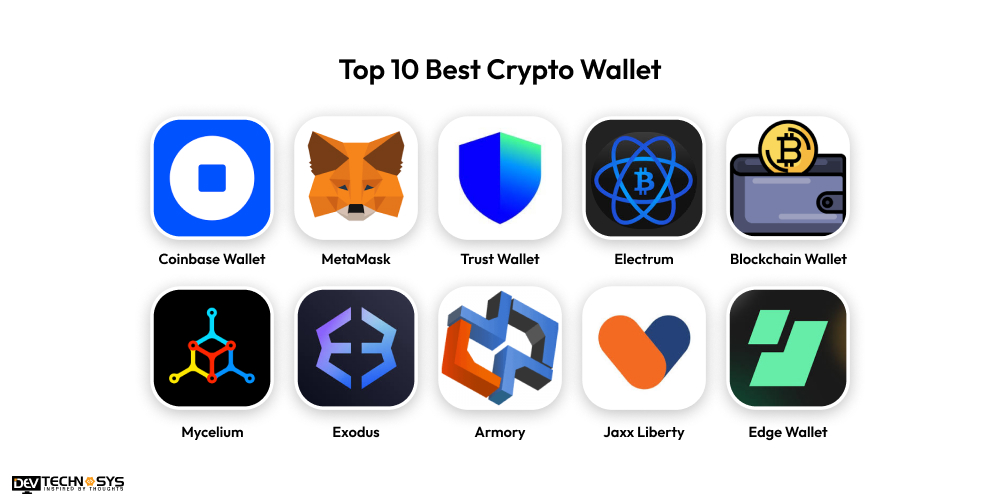
Apps |
Download Users |
Stores Ratings |
Apps Launched On |
Platform Accessibility |
| Coinbase Wallet | 10M+ | 4.6 | 2018 | Android, iOS, Web |
| MetaMask | 10M+ | 4.7 | 2016 | Android, iOS, Web |
| Trust Wallet | 10M+ | 4.7 | 201 | Android/iOS |
| Electrum | 1M+ | 4.3 | 2011 | Windows, Mac, Linux, Android |
| Blockchain Wallet | 1M+ | 4.4 | 2011 | Android, iOS, Web |
| Mycelium | 1M+ | 4.4 | 2013 | Android/iOS |
| Exodus | 1M+ | 4.6 | 2015 | Windows, Mac, Linux, iOS, Android |
| Armory | 500K+ | 4.0 | 2011 | Windows, Mac, Linux |
| Jaxx Liberty | 1M+ | 4.4 | 2016 | iOS, Android, Windows, Mac |
| Edge Wallet | 1M+ | 4.5 | 2014 | Android/iOS |
How To Build a Crypto Wallet?
Most businesses have the question of how to make a cryptocurrency wallet. This section clears all the questions that are related to the development. Building a crypto wallet involves a series of essential steps to ensure it is secure, functional, and user-friendly. Here are the 7 key steps to build a crypto wallet:
- Choose the Type of Crypto Wallet
- Select Supported Cryptocurrencies
- Implement Key Generation
- Design the User Interface (UI)
- Ensure Security Features
- Transaction Signing Mechanism
- Testing and Deployment
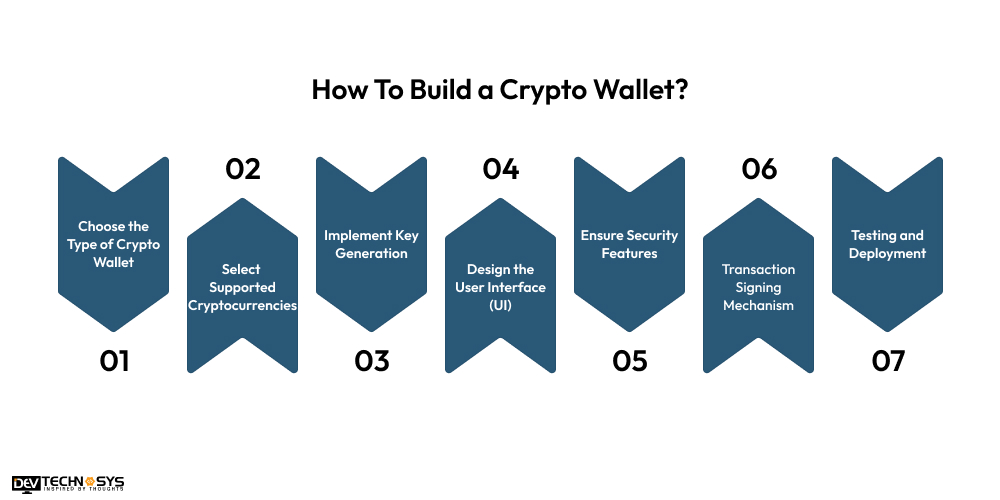
1. Choose the Type of Crypto Wallet
The first step in creating a cryptocurrency wallet is deciding what type of wallet you want to construct. Hot wallets are linked to the internet, which provides faster access but increases exposure to attacks. Cold wallets store keys offline, which improves security but limits rapid access. Choose whether your wallet will be custodial or non-custodial.
| Which crypto wallet offers more security, hardware or software? |
| What is the benefit of using a multi-signature wallet? |
| What is the difference between a hot wallet and a cold wallet? |
2. Select Supported Cryptocurrencies
Next, determine which coins your wallet will support. Popular possibilities include Bitcoin, Ethereum, and other altcoins. Each cryptocurrency has a separate blockchain protocol, thus your wallet must be linked with the appropriate blockchain network. Consult with an API developemnt company to use a multi-asset wallet, you will have to deal with multiple cryptocurrency protocols.
| Can I store both Bitcoin and Ethereum in the same wallet? |
| Why do some wallets support fewer cryptocurrencies than others? |
| What happens if a wallet doesn’t support a specific token? |
3. Implement Key Generation
The creation of private and public keys is essential to the functionality of a cryptocurrency wallet. The private key enables users to sign transactions, whilst the public key is used to collect payments. To ensure security, implement key generation using strong cryptographic techniques such as ECDSA (Elliptic Curve Digital Signature Algorithm) or EdDSA.
| Can I regenerate my keys if I lose them? |
| What is the role of entropy in a key generation? |
| How do hardware wallets generate and store keys securely? |
4. Design the User Interface (UI)
A user-friendly interface is necessary for adoption. The wallet UI should be simple and straightforward to use. The wallet’s balance display, transaction history, and ability to send and receive funds are all must-have features. Adding QR code capability can also help to ease transactions by allowing users to scan addresses and transfer funds quickly.
| What are the key principles for designing a user-friendly crypto wallet UI? |
| How do you ensure a responsive UI for different screen sizes? |
| How can you make crypto wallet security features accessible in the UI? |
5. Ensure Security Features
When creating a cryptocurrency wallet, security is of the highest priority. Use encryption to protect private keys and sensitive data. Hire experienced developers from an blockchain app development company to integrate the two-factor authentication (2FA) to increase security when accessing the wallet. Also, check that backup and recovery features are in place. If users lose access to their wallets, they can use a seed phrase to recover them.
| How does two-factor authentication enhance wallet security? |
| How can multi-signature authentication improve wallet security? |
| How can you ensure secure backup options for a crypto wallet? |
6. Transaction Signing Mechanism
Your wallet requires signing transactions with the user’s private key. Implement a technique for securely signing transactions and ensuring they reach the correct destination on the blockchain. This is an important feature that will enable consumers to engage with cryptocurrency.
| How do multi-signature wallets handle transaction signing? |
| Can a transaction be modified after it is signed? |
| What is the purpose of transaction signing in cryptocurrency? |
7. Testing and Deployment
Once the wallet has been developed, it must be properly tested. Hire cryptocurrency development company to conduct security audits, bug testing, and penetration testing to guarantee the wallet’s security and reliability.
After testing, deploy the wallet to your preferred platform (iOS, Android, or Web) and make it public. Ensure that your wallet is regularly updated with security patches and new features.
| How do you ensure wallet functionality on different devices during testing? |
| How do you deploy updates to a crypto wallet securely? |
| How do you monitor a wallet’s performance after deployment? |
What Features Does The Crypto Wallet App Offer?
Apps for cryptocurrency wallets usually have a lot of functionality to suit both new and seasoned users. The majority of cryptocurrency wallet apps have the following ten essential features:
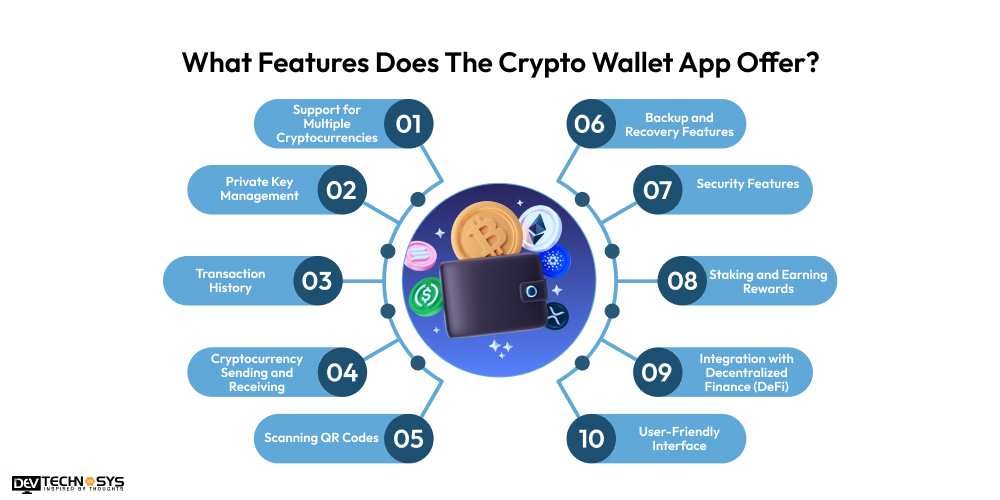
-
Support for Multiple Cryptocurrencies
The majority of crypto wallets enable users to store and manage a variety of cryptocurrencies, including Litecoin (LTC), Ethereum (ETH), Bitcoin (BTC), and many more. Tokens on particular blockchain networks, such as ERC-20 or BEP-20 tokens, are even supported by some.
-
Private Key Management
The private key that allows you to manage your cryptocurrency is kept in a crypto wallet. Good wallets protect the private key, usually by using backup options and encryption.
-
Transaction History
To monitor their cryptocurrency activities, users can view their previous transactions, including the dates, amounts, and transaction IDs.
-
Cryptocurrency Sending and Receiving
An app like Coinbase enables users to transfer and receive virtual currencies. Wallet addresses, which are often alphanumeric or QR codes, can be used for this.
-
Scanning QR Codes
To make transactions more convenient, a lot of wallets allow users to send or receive cryptocurrency fast by scanning QR codes.
-
Backup and Recovery Features
Most programs include backup features that can help you get back into your wallet in the event that you lose it. One such feature is the creation of a recovery phrase, sometimes referred to as a seed phrase.
-
Security Features
Wallets frequently come along with features like two-factor authentication (2FA), biometric authentication (facial ID or fingerprint), and multi-signature capability to further secure assets.
-
Staking and Earning Rewards
Without requiring users to transfer their assets to another platform, several cryptocurrency wallet apps let them stake specific cryptocurrencies in order to gradually earn rewards or interest.
-
Integration with Decentralized Finance (DeFi)
White-label Crypto Wallet allows users to swap tokens or take part in lending, borrowing, or liquidity pools directly within the wallet.
-
User-Friendly Interface
The majority of cryptocurrency wallets place a high value on having a straightforward, user-friendly layout. These wallets have dashboards that let users easily check their balances, keep an eye on market prices, and access options like settings and transaction history.
The Cost To Develop A Crypto Wallet App
The crypto wallet development cost varies depending on factors like complexity, features, and platform. Basic wallet apps can cost anywhere from $8,000 to $18,000, while more advanced ones with extra features like multi-currency support, staking, DeFi integration, and advanced security can range from $20,000 to $28,000. Customizations, such as integrating with hardware wallets or third-party services, can increase costs.
The development team’s location also impacts pricing, with rates differing by region. Ongoing maintenance and updates should be considered as additional ongoing costs. Thus, the total cost depends on scope and requirements.
Cryptocurrency Wallet Development Cost
Crypto Wallet Development |
Estimated Cost |
Time Frame |
| Basic Wallet Development | $8000 – $13000 | 2 to 5 Months |
| Mid-Premium Wallet Development | $13000 – $19000 | 5 to 9 Months |
| High-Premium Wallet Development | $25000+ | 9+ Months |
5 Major Factors That Affect The Crypto Wallet Development Cost
Creating a bitcoin wallet entails a number of variables and complications that may affect the project’s final cost. The cost of developing a cryptocurrency wallet varies greatly based on a number of variables, including the wallet’s functionality, security needs, platform preference, and the development team’s location. The five main elements listed below have a big impact on a cryptocurrency wallet’s development cost:
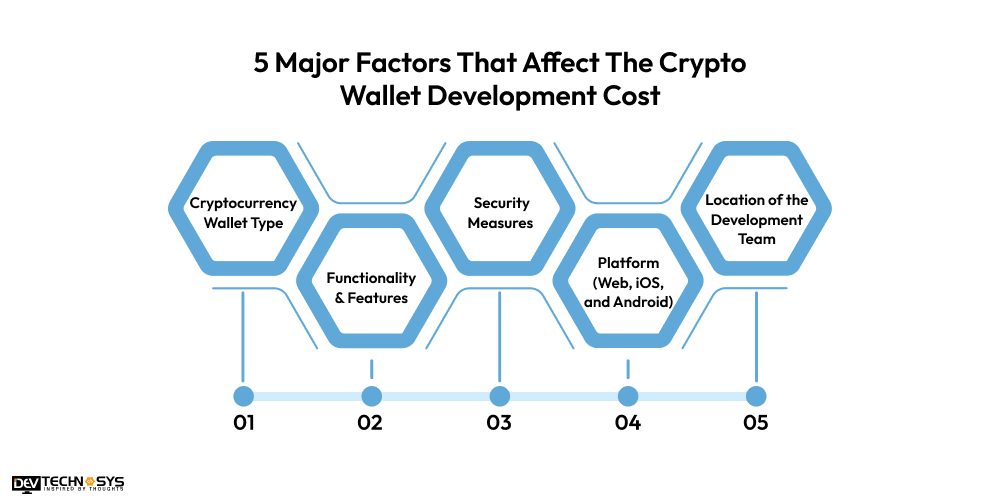
1. Cryptocurrency Wallet Type
Crypto wallets come in a variety of forms, each with unique features, technological specifications, and security factors. The cost is directly impacted by the complexity of the development process, which is determined by the wallet type you select.
i. Hot Wallets:
Because they prioritize accessibility and convenience, these wallets are typically simpler to create and have an internet connection.
ii. Cold wallets:
The offline cryptocurrency storage systems that are frequently more secure than hot wallets. Creating a cold wallet is more expensive since it requires working with hardware.
iii. Web wallets:
Although they can be less expensive to create than mobile wallets, they still need a lot of backend connectivity, particularly for transaction processing and data storage.
| Cryptocurrency Wallet Type | Cost Estimation |
| Hot Wallet | $5,000 – $15,000+ |
| Cold Wallet | $15,000 – $20,000+ |
| Web Wallet | $25,000+ |
2. Functionality & Features
The crypto digital wallet development cost can be greatly impacted by the kind and quantity of features you incorporate. It will be less expensive to create a simple wallet, but more time and money will be needed to create more sophisticated features. Typical characteristics that may affect the price include:
i. Support for numerous Currencies:
Adding support for numerous cryptocurrencies necessitates integrating distinct APIs for every asset, which raises the cost and duration of development.
ii. Private Key Management:
Adding complexity and ensuring security requires the safe storage and management of private keys, along with features like multi-signature authentication.
iii. Staking and Yield Generation:
Enabling users to engage in yield farming or stake their cryptocurrency may complicate the wallet’s technical and legal aspects.
| Features | Cost Estimation |
| Core Features(Private Key Management) | $8,000 – $12,000 |
| Advanced Features(Backup and Recovery Features) | $15,000 – $20,000 |
3. Security Measures
Because consumers store valuable digital assets in crypto wallets, security is crucial. The cost of development increases with the sophistication and strength of the security measures. Among the security features that affect crypto wallet app development cost are:
i. End-to-End Encryption:
Protecting user data and transactions requires that all data sent between the wallet and server be encrypted.
ii. Two-Factor Authentication (2FA):
This feature raises the cost and complexity of transactions by adding an extra degree of security when users log in.
iii. Biometric Authentication:
Adding facial or fingerprint recognition to wallet access will increase expenses and development time.
| Security Measures | Cost Estimation |
| Advanced security (encryption, 2FA, cold storage, multi-sig) | $5,000 – $15,000+ |
4. Platform (Web, iOS, and Android)
The total cost may vary depending on the platform the wallet is designed for. Because separate codebases or cross-platform frameworks are required, the cost is usually higher if you want your wallet to be accessible on various platforms (Android, iOS, and Web).
| Platform Type | Cost Estimation |
| Web Platform | $10,000 – $13,000+ |
| iOS Platform | $20,000 – $25,000+ |
| Android Platform | $19,000 – $24,000+ |
5. Location of the Development Team
The geographical location of the development team might have a significant impact on the cost of blockchain wallet development. Regional variations in hourly rates might have a big impact on the entire budget. For instance:
i. North America/Europe:
Development fees are high in places like the United States and Western Europe, usually between $100 and $250 per hour.
ii. Eastern Europe and Asia:
These areas provide excellent developers at competitive prices, usually between $30 and $75 per hour.
| Developer’s Location | Cost Estimation |
| Asia Pacific | $8,000 – $15,000 |
| North America | $15,000 – $20,000 |
| Eastern Europe | $13,000 – $18,000 |
| Western Europe | $16,000 – $25,000 |
How To Reduce The Crypto Wallet Development Cost?
By using smart strategies, it is feasible to lower the cost of creating a cryptocurrency wallet without sacrificing its usability, security, or usefulness. Here are a few strategies to reduce the cost of development:
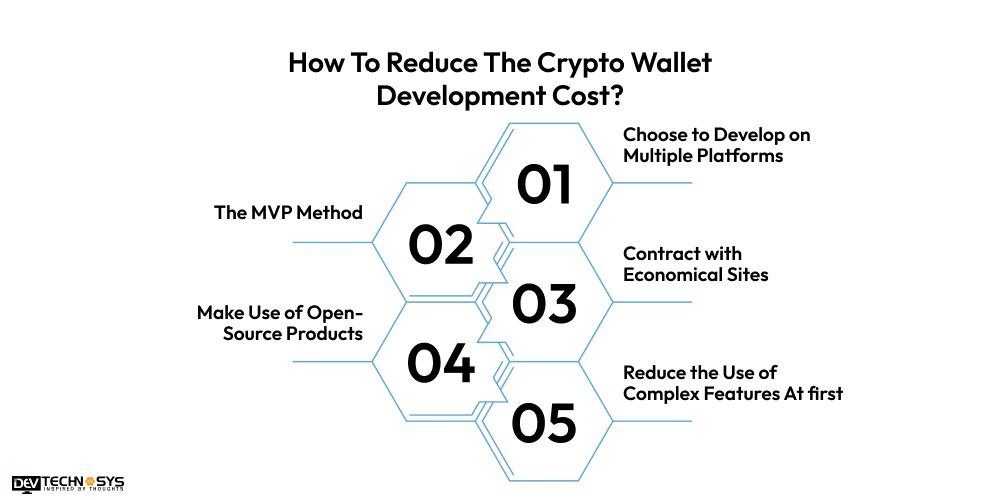
1. Choose to Develop on Multiple Platforms
Use cross-platform development frameworks such as React Native or Flutter rather of creating distinct native apps for iOS and Android. This guarantees uniformity across devices and drastically cuts down on development time and expenses by enabling you to create a single codebase for both platforms.
2. The MVP Method
An MVP app development should come first. Create a rudimentary version of your cryptocurrency wallet that includes the necessary functions, such as transaction history, user registration, and wallet balance monitoring.
Steer clear of including sophisticated features (such as yield farming, staking, or in-wallet trading) during the early stage. Based on user feedback, you can add these features after launch, which lowers the original expenditures.
3. Contract with Economical Sites
Think of outsourcing development to areas like Asia (e.g., India, Ukraine) or Eastern Europe that offer lower hourly costs. In comparison to developers in North America or Western Europe, high-quality developers in these regions charge substantially lower prices. But be sure to thoroughly screen the team for blockchain technology knowledge.
4. Make Use of Open-Source Products
Use open-source tools and libraries instead of creating everything from scratch. Numerous wallet libraries and blockchain frameworks are either free or inexpensive. By incorporating these tools into your project, you can reduce the amount of time and money needed to develop the essential features.
5. Reduce the Use of Complex Features At first
Offering a plethora of sophisticated features, such as support for decentralized finance (DeFi) or multi-signature authentication, may be alluring, but doing so can be quite expensive and complex. Prioritize essential features that can be added later, such as safe transactions and simple wallet operations.
Conclusion
In conclusion, we explored how to make a crypto wallet and how to get Bitcoins wallet. Several variables, including wallet type, functionality, security protocols, platform selection, and development team location, affect the crypto wallet development cost. Businesses can cut expenses without sacrificing quality by utilizing cost-effective solutions, cross-platform development, and prioritizing critical features.
When developing a crypto wallet, striking a balance between functionality, security, and affordability requires careful planning and a well-defined timeline.
If you want to create a crypto wallet with extensive functionality, you can reach out to a crypto wallet development company to receive development solutions within budget.
Frequently Asked Questions
Q1. How Much Does It Cost To Develop A Crypto Wallet App?
The crypto wallet development cost varies, typically ranging from $8,000 to $25,000, depending on features, platform, security, and development complexity. Customization and integrations can increase costs.
Q2. How Much Time Does It Take To Build A Crypto Wallet App?
Depending on features, security protocols, complexity, and the experience of the development team, make a cryptocurrency wallet app normally takes 3 to 9 months. The timeline may be prolonged by integrations and customizations.
Q3. How To Create A Wallet for Cryptocurrency?
Selecting a wallet type (software, hardware, or paper) is the first step in creating a cryptocurrency wallet. Use a hardware wallet or download a reliable wallet app. Create a public address and a secure private key. For extra security, set up backup recovery phrases and turn on multi-factor authentication. Make sure you have backups on a regular basis.
Q4. How To Reduce The Cost To Create A Crypto Wallet?
Focusing on key functionality, utilizing open-source frameworks, utilizing pre-built libraries, minimizing customization, and choosing cross-platform development are ways to lower the cost of developing a cryptocurrency wallet.
Q5. what is a Non Custodial Crypto Wallet?
A non-custodial crypto wallet lets users fully control their private keys and funds without relying on third parties, offering enhanced security and privacy by keeping assets and transactions directly managed by the user.
Q6. What is the Difference Between a Custodial and a Non-Custodial Wallet?
A custodial wallet stores your private keys and manages your crypto on your behalf, relying on a third party. A non-custodial wallet gives you full control of your private keys and funds, ensuring greater security and personal ownership.
